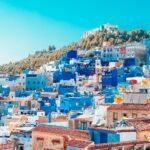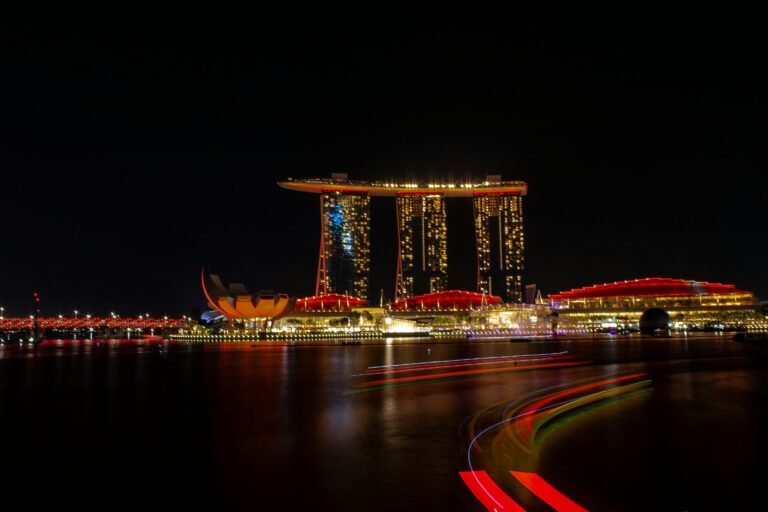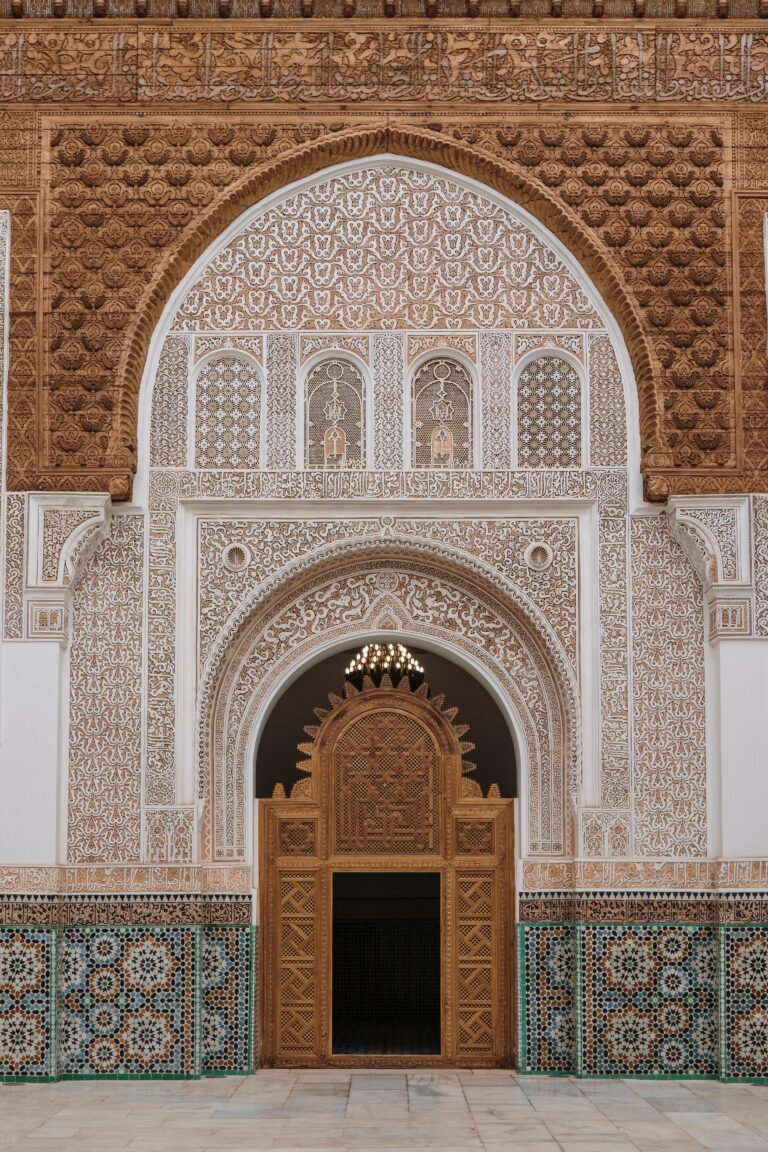Main Info
Embark on a captivating journey through Morocco’s rich history and vibrant culture, starting with a scenic tour of Casablanca’s iconic landmarks, including the stunning Hassan II Mosque. Explore the ancient medinas of Fez, marvel at the Roman ruins in Volubilis, and experience the enchanting allure of Marrakech with its bustling souks and majestic palaces.
| Included | Round-trip airport transfers 1 night in Casablanca 3 nights in Fez 3 nights in Marrakech 14 meals: 7 breakfasts and 7 dinners Casablanca City Tour Rabat City Tour Visit Meknes and Ifrane Half board (Breakfast and Dinner, including a dinner at a local restaurant in Marrakech) Modern transportation with an English-speaking driver (bottle of water available in the car) Full-day guided tour of Fez and Marrakech Guided tour of Volubilis Monuments and historical sites entrance fees as per the itinerary Porterage at the hotels All taxes IMPORTANT NOTE: For groups of 5 or more travelers, a national guide is included who accompanies your group throughout the trip. For groups of fewer than 5 travelers, a national guide can be arranged for $182 per day, with the cost divided among all participants. |
| Excluded |
|
| Hotels or Similar Standard Hotels: Casablanca: New Hotel or similar Fez: L’Escale or similar Marrakech: Bab Hotel or similar Superior Hotels: Casablanca; The Gray Boutique Hotel Fez: Les Merinides Marrakech: Grand Mogador Menara |
Itinerary
Upon arrival in Casablanca, please proceed through customs and immigration formalities. Our representative will meet you outside the Arrival Terminal with a sign. A brief review of the tour during your transfer to the hotel. Check in and relax.
In the afternoon, your diver will meet you at the hotel to enjoy a half-day guided tour of Casablanca, Morocco’s largest metropolis and industrial hub (subject to your time of arrival). Highlights include the old French quarter of Habous with its beaches lapped by green-blue water. During your tour, you’ll visit the Hassan II Grand Mosque (exterior). The mosque is among the largest in the world with its minaret, the tallest religious structure in the world, and its dimension, it can house as many as 25,000 worshipers! Continue to your hotel for dinner.
Overnight in Casablanca | Meals: Dinner
After breakfast, depart towards Rabat, driving along the main highway which links these two major cities. Embark on a brief tour that highlights Rabat’s cultural influences and the superbly preserved relics of its Moorish past. Rabat’s most famous site is the 12th-century Hassan Tower (an excellent example of the gorgeous Moroccan style), the incomplete minaret of the great mosque built at the beginning of the 12th century. Alongside is the mausoleum dedicated to Mohamed V, the grandfather of the current king. You’ll also enjoy a visit to the Kasbah of the Udayas, which was built on a cliff overlooking the city and the Atlantic ocean. Its gate is one of the most beautiful illustrations of the Moorish architecture. Within its walls, you’ll discover a wonderful Moroccan garden, with melodious fountains and sweet-smelling orange trees. After your sightseeing, continue inland to Fez (approximately a 3-hour drive) and to your hotel for dinner.
Overnight in Fez Meals Included | Breakfast, Dinner
Today you take a step back in time to the Middle Ages with the visit of one of the imperial, timeless, and untouched cities in the world, the cultural heart of Morocco, Fez El Bali (Old Fez). Enjoy exploring some of the 9,000 narrow lanes and alleys in the souks (open-air markets) that make-up the labyrinth of the city’s old quarter, originally founded in the 8th century. The Imperial capital was a renowned medieval learning center, and at its heart remains the Karaouine, one of the oldest,
still functioning universities in the world. Nearby is the Attarine Medersa (Koranic college), a jewel of Hispano-Moorish architecture, built in the 14th century. Then you’ll visit Nejjarine Square, with its beautiful fountain, a mosaic of elaborate tile-work, and the Fondouq (Caravanserai) that has been Centre Koutoubia 2, converted to a Museum of Carpentry. In the 13th Century, the Merinide Dynasty built Fez El Jdid (New
Fez) with its Royal Palace, mosques, madrasas (Koranic schools), souks, and the city walls. Most notably, Fez El Jedid is home to the Mellah (Jewish quarter), which provides an interesting insight into Jewish architecture. The wrought iron decorated windows and splendidly carved wood balconies
of the old mansions are particularly outstanding. The medieval Medina is a UNESCO World Heritage Site. Return to your hotel for dinner.
Overnight in Fes
Meals Included | Breakfast, Dinner
After breakfast, we drive to the ancient Roman city of Volubilis to explore its stunning ruins.Impressive stone arches and columns, some tumbled down and others still standing tall against thevivid blue sky. Only about half of the 40 hectares of UNESCO World Heritage site have been excavated.The better-known monuments are in the northern part of the site, farthest from the entrance in thesouth which is: the Capitol, dedicated to the Triad of Jupiter, Juno, and Minerva, dated 218AD, theBasilica, and the 1,300 m2 Forum. Pay attention to the floors of what were once family dwellings thatare still covered with decorative tile mosaics depicting mythological beings, such as Orpheuscharming animals with his lyre and Hercules performing his legendary 12 labors. That so many ofthese tiles are still in place and exhibiting their colors after centuries of exposure to the elements, which isastonishing.Next, we will visit the whitewashed town of Moulay Idriss, about two miles from Volubilis. It sitsastride two green hills in a cradle of mountains, where Morocco’s first Arab conquerors settled. Thenoff to the Imperial city of Meknes, the one-time home of the Moroccan sultanate with its Medina all winding narrow streets and grand buildings that justify its stamp of Imperial City. Remnants of threefortifications, ingeniously incorporated into the city road network, emphasize its pastimportance and glory. The king’s tomb sits at the heart of what remains of the original city, flankedby an almighty royal granary, the magnificent Bab el-Mansour. Drive back to Fez for dinner andovernight at the hotel.
Overnight in FezMeals Included | Breakfast, Dinner
Today we experience the natural and wilder landscapes outside Fez: Drive to the high alpine region of Ifrane, filled with cedar and oak forests, and home to the world’s largest population of Barbary macaques, hundreds of animals, birds, and the oldest tree in Morocco’s the Middle Atlas, the 130-feet Gouraud’s Cedar. The largest cedar forest in the world is found in this park, and several Lakes or Dayats abound in the nearby area. The Lion of Ifrane sits majestically in the city center and is certainly one of the most photographed sites in the region. Ifrane feels more like Switzerland with its clean air, scrubbed streets, and leafy outlook. The French built this city in 1930, deliberately trying to re-create an alpine-style resort. It is a popular day trip for picnickers during summer and the site attracts the skiers in the winter. Stop for lunch (on your own). Continue to Marrakech via the highway for dinner and overnight.
Overnight in MarrakeshMeals Included | Breakfast, Dinner
Unearth the secrets of Marrakech, starting with the Medina, the old walled section of town and aUNESCO World Heritage Site. This thousand-year-old city was long a political, economic, and culturalcenter. Marvel at its architectural jewels, including the soaring Koutoubia minaret. Continue to theBahia Palace is an exemplary specimen of privileged life in the 19th century. Your next stop is TiskiwinMuseum (MaisonTiskiwin), which houses an impressive collection of North African arts and crafts.The museum, which was founded by a Dutch anthropologist, is organized into geographically themedexhibits, with each room focusing on artifacts from different towns and regions along the ancienttrade route Marrakech-Timbuktu. The works on display include exquisite hand-woven carpets andtextiles, traditional Berber clothing and jewelry, intricate basketwork, and tribal handicrafts. Lateryou’ll visit Marrakech’s main square Djemaa el-Fna, which is filled with orange juice stalls andvendors, along with fire-eaters, mime artists, snake-charmers, fortune tellers, magicians, and streetmusicians performing at every turn. You may also take the opportunity to explore the city’s fabled,labyrinthine souks, their bustling alleyways brimming with all manner of wares. Following your visit,return to your hotel. The remainder of the day is at leisure, a perfect opportunity to freshen up andget ready for dinner in a local restaurant. Return to your hotel overnight.
Overnight in MarrakeshMeals Included | Breakfast, Dinner
Day at leisure. Wander around on your own or sign up (own expenses - please inquire for pricing) for a full-day farm retreatwith cooking class, an excursion in Agafey Rocky Desert or Essaouira, or a Day with a BerberFamily at Imlil Valley. Dinner and overnight at the hotel.
Overnight in MarrakeshMeals Included | Breakfast, Dinner
Meals Included | Breakfast




